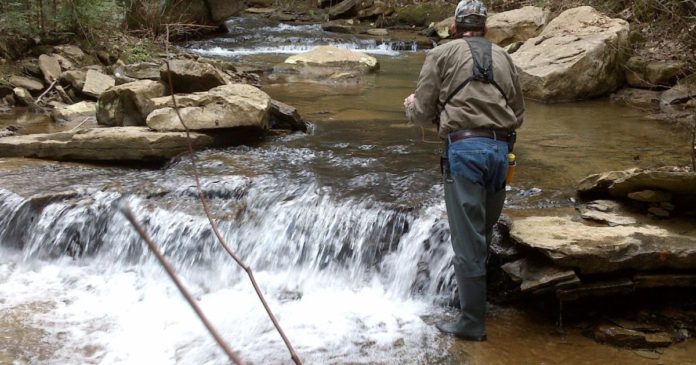Recent heat waves remind us that summer is close at hand. This spells warming water and the end of another trout season for many anglers. But for those willing to hike into the forested high country of our state and sample the native brook trout fishing found in the headwaters runs found there, exciting sport can be enjoyed throughout the summer months.
Few fishing options require less in the way of fishing tackle than one geared toward backwoods natives. The streams and runs that support native brook trout tend to be of limited fertility, i.e., there isn’t a lot to eat. While the fish are shy — instinctively hiding from avian and mammal predators — they also are aggressive feeders. If you don’t spook them, odds are you will catch them as they can’t afford to allow potential food to drift by.
Fly and spinning gear are appropriate for backwoods natives. The key word here is “short.” I’ve found fly rods in the 7- to 7.5-foot range to be ideal. I have one of each, one being of fiberglass, the other a value-priced graphite model. There’s no need for a longer rod, nor one of higher quality. Rarely will one be making a classic cast involving a back cast. Rather, casts typically are mere flips akin to a bass angler making a flip or pitch to shallow, heavy cover. Or a bow-and-arrow cast that shoots the fly nice and low under the overhead cover common to good native streams. Whatever it takes to put a fly in front of a potential trout.
Also, sorties of this nature are subject to misadventure. Rods hitting overhead branches during a hookset, getting stabbed into the bank while climbing up it, driven into the ground when you slip on a moss-covered rock. Better to snap a cheap rod than an expensive one.
Since many of the casts will be flips, it’s a good idea to go a size up from the rod rating. Both of my rods are 3 weights, but I fish 4 weight lines for the added weight to assist in such casts. It’s also smart to keep leaders a tad shorter than the rod length. This way the leader-to-line connection stays outside the tip top when you secure the fly to the keeper, which you will do a lot moving from spot to spot along the bank.
Ultralight spinning rods in the 5- to 6-foot range will also work fine, ones coupled with either a size 500 or 1000 spinning reel loaded with four-pound test monofilament.
Fly/lure selection is also simple. Native brookies succumb to brightly colored flies. I’ve found bright, downsized Woolly Buggers effective as well as Green Weenies. Both patterns can be tied in pink or salmon colors that brook trout respond to especially well; I’ve found wild browns and wild rainbows like them as well when they are present.
A tandem dry fly/dropper rig is another way to go, with the dry being a buoyant, bushy pattern like a Humpy with a wet fly or nymph on the dropper. While the dry serves as a strike indicator, often the trout hit take the dry.
Small spinners and spoons on ultralight spinning gear catch trout, but I’ve found that streamers and Green Weenies fish well on this gear with the addition of a small split shot for weight. The treble hooks found on hardware can be tough on the delicate mouths of a native brookie. Consider pinching down the barbs on all hooks for this reason.
Rounding out gear needs are lightweight hip boots or waist high waders as sometimes you’ll need to kneel near the stream (or in it) to make a proper cast. Choose wading shoes based more on comfort and support on the walk in and out rather than instream as little wading is necessary. Include a daypack or sling pack to carry basic fishing essentials as well as snacks and water, and you’re set for the day.
Natives will use whatever cover is available to hide from predators, jutting out in a flash to intercept food (or your offering). This includes deeper pools scoured at stream bends; plunge holes below falls, riffles and bank-to-bank logs; undercut banks; tree branches imbedded in the bottom; and rocks and boulders.
As mentioned earlier, fishing in an upstream direction is highly preferable. If you’re with a friend, it’s smart to leapfrog spots so you’re each fishing fresh water. If possible, keep each other in view so you know what’s been worked.
Fly/lure presentation is a matter of getting your offering upstream of the target area without disturbing the surroundings and alerting the fish. Stay back from the bank as much as possible maintaining a low profile. Keep your shadow off the water. Wear muted colors. Keep footfalls soft as you approach a spot. I’ve taken brookies from undercut banks I was standing on by doing so.
On longer holes be sure to fish the tail first. It’s possible to pull a fish from there first and get another unspooked one from the head of the pool. Other than under high-water conditions rarely will you get more than a couple fish from a spot.
You will need to be creative in your casting. The casts need not be pretty. Natives will hide in some less-than-obvious places and you’ll find yourself casting over submerged branches and such, adopting a “catch them first, then worry about getting them out of there” attitude.
It’s often said that there’s a lot more to fishing than catching fish. This is certainly true with backwoods natives. In a world where things seem to have become increasingly artificial and fabricated, it’s refreshing to catch native species that have been here for eons, morale boosters to know they remain.
Credit: Source link































